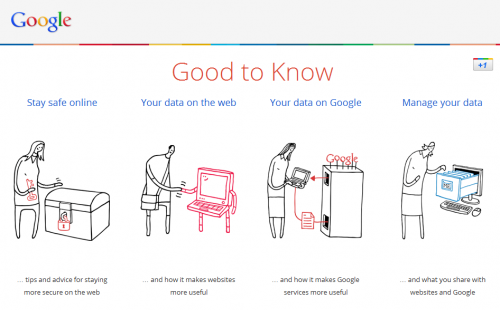Many of you probably got an e-mail last week from Google announcing its new privacy policy. Every site has a privacy policy, and as a marketer, I understand the need to make some use of the information. After all, Google gives a lot of stuff for nothing–I depend on Gmail, Google Calendar, and many other free functions–so it is only fair that we give something back. I personally am fine with allowing Google use of my data, but I do like to read exactly what they are allowed to do. That’s where I ran into trouble.
I mean, I want to read the new privacy policy, but I don’t want to spend my day doing it. When I clicked through on the e-mail, I was faced with a Web page that had some material on it, but at the bottom, several different paths to take:
So, now, no matter what I click into, I have to backtrack and then click the other two links to make sure that I read everything. OK, fair enough. It makes sense that the privacy policy might be lengthy, especially because Google is delivering one policy to cover every one of its products. And, usually, I wouldn’t complain that someone took a lot of information and broke it up into bite-size chunks to make it easier to digest. So, I clicked on the first link and got the next screen:
So, now this is getting a little ridiculous. I think I’d need a pen and paper to make sure I read every branch here, because who knows how many more there are. And a lot of them don’t really seem like privacy policy material–more like general Web safety tips, which I can get elsewhere if I want them. No, the privacy policy is kind of a legal document. It’s a contract between Google and me. I give up dome privacy in return for getting to use free software. I think it’s a good deal, but it would be nice to read exactly what I am giving up to be sure.
So, I acted like the normal Web surfer–two clicks and I haven’t found what I want, so I am outta here. I went to Twitter to complain about how painful it is to see what the privacy policy is about, and I was rewarded with a long Twitter conversation with a couple of smart folks. (The cool thing about Twitter is that your followers always know more than you do, so its a great way to get informed.)
David Iwanow (@thelostagency) quickly introduced me to Kristine Schachinger (@schachin), an expert in such matters. She has a great background article that explains why Google is changing its privacy policy that she wrote back in December. Google has become a credentialed authenticator of identities, which is why it HAD to bring all of its products under a single privacy policy. When I spoke to Kristine on Twitter, she said, ” Google+ is NOT a social network. Eric Schmidt said it himself. It is an Identity Network.” That might not mean anything to you, but, remember that a privacy policy is a legal document. To the lawyers, it means everything.
Google has stepped up to meet the regulatory requirements, and in so doing, they’ve found a way to get exactly what they want while staying completely within the law. I asked Kristine if this new privacy policy is just another Facebook-like sleight of hand, and Kristine told me that “Facebook could learn from Google on this one.” She noted that ” Google is using the ‘frog in a slow boiling pot won’t notice’ strategy.”
So, Google is outsmarting everyone again. Sure, it’s a good deal for users to get free e-mail and other functions, but Google is definitely monetizing everything. And although legislators and regulators stand up and pound their chests on how they will reign in privacy abuses, Google is calling their bluff by complying with every regulation. And, in so doing, Google gets exactly what it wants.
When I worked at IBM, I noticed that one of IBM’s core competencies was lawyering. Looks like Google didn’t miss that lesson, either.








